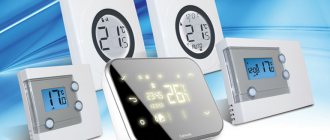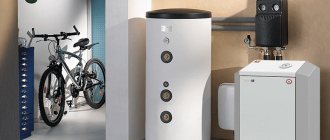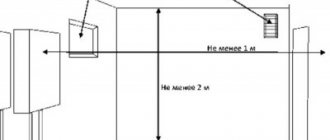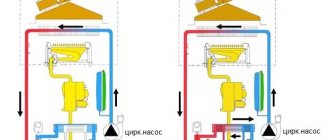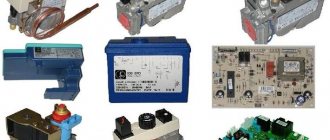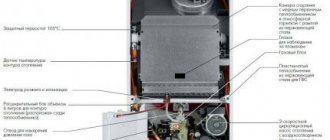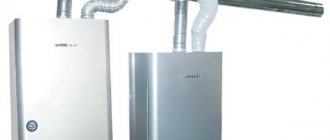Heating is one of the most important concerns for owners of private houses or premises.
Connection to centralized networks is not available to everyone, and high tariffs are pushing for the creation of autonomous systems.
Baksi heating boilers are one of the reliable and effective solutions to the problem, providing a complete replacement for network resources.
They are capable of providing a house or other premises with hot water, supplying coolant to a heating system or underfloor heating.
A useful feature of Baksi boilers is the ability to connect additional devices that improve the operating mode of the units.
What is a room thermostat and why is it needed for a gas boiler?
A thermostat is a device that maintains temperature at a certain, predetermined level..
It is used in many technical and technological installations where it is necessary to maintain certain environmental parameters.
Basically, thermostats are used in heating systems, in internal combustion engines, heating installations and other devices.
For a gas boiler, a thermostat serves as a convenient and useful addition. When the room reaches the desired temperature, it turns off the heating of the coolant, and when it drops, it starts the process again .
The specificity of the device’s operation is to control the temperature of the internal atmosphere in the room (some models simultaneously determine the external temperature, making additional adjustments to the operating mode when it changes).
Own sensors installed in boilers only monitor the temperature of the heating agent. Situations often arise when the coolant is heated to the required value, but the room is cool due to frequently opened doors, windows, etc.
To create a comfortable temperature, you have to often change the operating mode of the boiler, distracting yourself from your business to reconfigure. Using a thermostat relieves the owner of this concern; temperature correction is carried out automatically .
IMPORTANT! The thermostat allows you to save about 25-30% of space heating costs, which is very attractive for any owner.
Programmable room thermostat
A programmable electronic room thermostat allows you to select the desired and comfortable temperature at any time; it is easy to reconfigure and change the operating mode. The timer allows you to set a different heating pattern on weekdays and weekends. Some timers allow you to set different settings for each day of the week, which can be useful for people who work part-time or shift work. Many Terneo and KChM models are equipped with such thermostats.
Programmable room thermostat
A programmable room thermostat allows you to set individual heating standards for each day in accordance with your lifestyle and maintain the temperature of the house all the time, regardless of the presence or departure of the owners. Video: Connecting a room thermostat to a gas boiler
If the heating system is controlled by a boiler with a radiator, as a rule, only one programmable room thermostat is needed to control the entire house. Some patterns need to be adjusted in the spring and fall as the clocks move forward and backward or certain changes in climatic conditions occur. We also recommend changing the temperature settings when changing from day to night.
This climate controller has several options that expand its capabilities:
- “Party”, which stops heating for several hours, then resumes;
- “Override” allows you to temporarily change the programmed temperatures during one of the configured periods;
- “Holiday” increases the heating intensity or reduces it for a certain number of days.
Principle of operation
A control board is installed inside the boiler, which controls all the actions of the unit components. It has special contacts, which by default are connected by a special jumper. They are used to connect the thermostat.
While the jumper is in place, the operation of the system is subject to its own logic - the coolant temperature is set, the boiler heats the heating agent to the specified parameters and turns off when they are reached until the water cools down to the lower limit.
When connecting the thermostat, the jumper is removed. The device turns out to be connected to the gap, so all control of the boiler operation passes to it. The work process becomes smoother, frequent starts and stops of heating stop. The air temperature changes more smoothly.
This method of control gives a more successful effect, allowing you to reduce gas consumption and seriously save on heating.
Kinds
There are many design options for room thermostats. For Baxi boilers, it is possible to use any of them, which is very convenient for users.
All types of thermostats can be divided according to individual characteristics:
Installation location
According to the installation location, all thermostats can be divided into indoor and outdoor (external). The first ones are mounted indoors, the second ones are placed outside and monitor the state of external weather and temperature conditions.
Most owners prefer to control the internal conditions of the premises, since they have a greater impact on the microclimate of the home. External devices are suitable for residents of southern regions, where the thermal insulation of walls is not so effective.
Control method
Existing control methods:
- Mechanical.
- Electronic.
- Remote.
The first version of the devices is based on changing the volumes of liquids or gases in closed containers with a membrane. These devices operate only in real (current) time and are not programmable.
Electronic thermostats are much more accurate than mechanical ones. The measuring instrument is a thermistor, which changes resistance as the temperature rises or falls . They have a high response rate and are capable of programming some time in advance.
Remote control is carried out using computers or smartphones. To do this, WiFi or GSM modules are installed in the device, providing remote communication between the user and the thermostat. Such models are the most expensive, but their capabilities are much wider than those of conventional models.
Principle of operation
Based on the principle of operation, devices are divided into mechanical and electronic. They operate on different principles described above.
The choice of one type or another is determined by the operating conditions and characteristics of the premises. The more accurately and more often it is necessary to adjust the operation of the boiler, the higher the need for electronic devices. If the operating mode is adjusted within small limits, it is possible to install a conventional mechanical thermostat.
Types and principle of operation
There are a large number of varieties of room thermostats for the boiler, from expensive wireless devices to mechanical devices. Thanks to even simple electronic equipment, the cost of purchasing it quickly pays off. But the benefits of its use are very significant, and this has long been noticed by many owners of gas boilers.
Thermostats can be operated using:
- connections to the boiler electronic board;
- built-in rechargeable battery;
- electrical network.
Equipment can be remote, built-in, digital, analog, wireless and wired.
The cost will depend on the specific model, which varies in the range of 200–15,000 rubles. The most expensive are wireless devices that control the operation of the boiler using a radio signal. The cheapest are mechanical models that are connected using a special cable.
The thermostat can be operated, for example, from a battery
The most advanced are wireless devices with a digital screen that displays the current room temperature and other parameters. Modern thermostats for gas heating boilers have the ability to select up to 7 temperature setting modes.
Electromechanical, electrical, mechanical
Mechanical equipment is the most affordable device. They are connected to the boiler using a two-core cable and fixed to the wall at a distance of 50 cm from window or door openings, and also away from direct sunlight.
Main characteristics:
- measurement error - 1°;
- the measurement range varies in the region of 3−45°;
- approximate power 4 kW;
- gas-filled siphon.
The thermostat is connected to the boiler by two copper cables, and the necessary commands are transmitted through them. The required temperature parameters are set by rotating the knob.
Electromechanical models are the most modern devices, which can provide temperature control with an error of no more than 1%. Inside this equipment there is a thermal relay, signal and temperature sensors. The cost of electronic devices is higher compared to mechanical ones.
Main characteristics:
- convenient digital screen;
- the measurement range is within 7−30°;
- temperature determination with an accuracy of 0.2°;
- humidity control;
- multicore cable;
- installed LED for illumination.
These devices have a very small error.
Electrical devices can be programmed for a day or a week, set up to 7 time intervals with a specific temperature, there is also a “vacation” mode and a sleep mode. The boiler operation is monitored using an LCD screen. There is a relay inside electrical appliances, which is responsible for turning the boiler equipment on and off. This equipment is slightly more expensive than mechanical devices, but cheaper than electromechanical ones.
There are devices equipped with a capillary tube, as well as with a group of contacts and a bimetallic plate. In the latter version, the boiler is turned on due to the fact that the plate, heating up to a given temperature, bends and opens the contacts. In the first option, the signal is transmitted due to the expansion of water in the tube during heating.
Basic indicators:
- stainless steel siphon;
- measurement range varies between 7−45°;
- automatic heating shutdown;
- convenient screen for programming temperature.
The control accuracy in these devices is not very high.
Remote controlled and wired
There is a special wire in the device for transmitting the command. These are affordable devices that are rarely found in stores today.
These thermostats can be manually programmed to the desired temperature. There are also expensive wired devices that regulate the coolant in the heating circuit due to the temperature characteristics in the room.
Devices with remote control have a remote control that transmits a signal over a distance of up to 50 m.
The equipment memory is non-volatile. If there is a power outage, all data is saved. In some cases, one remote control can run several devices simultaneously. Connecting a GSM module or control system using Wi-Fi can only be done for wireless thermostats.
Programmable and regular
Conventional devices have an on/off key, as well as a rotating dial for manual temperature programming. This is the simplest equipment, very cheap. As a rule, it is purchased for a summer house or other housing in which strict control over the heating system is rarely necessary.
Programmable devices make it possible to set the required temperature indicators. They have a programming function (up to approximately 7 temperature switching functions per day). You can set one daily program for weekdays and another for weekends or individually for all days of the week. Optimal programming of the sensor lowers the room temperature if there are no occupants at home, and also, for example, at night.
Savings with programmable equipment are much higher than with a simple thermostat (up to 45%). Expensive devices may have an EBus communication bus and other functions. EBus makes it possible to exchange information between the sensor and the heating boiler and, thus, change the power based on the signal from the thermostat, taking into account the programmed temperature in the house.
Devices with a hydrostat are not ordinary devices, but equipment with the ability to control the level of humidity in the house. You can monitor the humidity and select a decrease or increase function.
Indoor and outdoor
There are weather-dependent thermostats that control the room temperature taking into account the weather conditions outside. If it’s cold outside, the boiler will independently increase fuel consumption, and during warming, the heating will decrease.
You can control this device using your phone or other gadget. The price of weather-sensitive devices starts from 7 thousand rubles. Thermostats are more economical and are quite in demand today.
Outdoor equipment is protected from frost. Thermostats may have modes such as “vacation” or “meeting”, that is, it is possible to meet the owner after absence with the required temperature or reduce energy consumption to a minimum while the residents are away from home.
Room equipment is installed indoors and operates thanks to air circulation, rather than heating the coolant in the boiler. The device is equipped with a digital screen and can be programmed. One device is installed for the entire house and it operates using a bimetallic spring.
This equipment can only be installed at a distance of 1.2 m from the floor level and away from a constant source of draft. The device will turn off the boiler if the room temperature reaches a preset threshold and turn it on if the temperature drops by a few degrees.
Additional useful options
Some thermostat models solve only basic problems without having any additional options.
More advanced samples, in addition to basic functions, are capable of performing some related actions that expand the capabilities and efficiency of the device. For example, in addition to monitoring room temperature, there are options for monitoring weather conditions outside and making adjustments to the heating mode in accordance with them.
In addition, there are other options:
- Several options for room thermal conditions.
- Programming individual settings.
- WiFi Internet access with the ability to remotely program the mode.
- GSM module for working with a smartphone via SMS.
- Protection against unauthorized mode changes (child lock).
- Decorative lighting.
- Protection against overheating or freezing.
- Hydrometer with the function of changing air humidity.
It is up to the owner of the thermostat to decide how necessary these functions are, since they are not available in all models. By choosing the most suitable option, you can immediately determine the list of required options and purchase the desired sample.
How does a heating thermostat work?
A conventional heating system with water as a coolant consists of heating equipment or a connection point to a centralized network, internal wiring pipes and radiators.
To regulate the volume of heat coming from it into the rooms, you have to either constantly monitor the boiler or regularly close/open the valves on the radiators.
At the same time, the inertia of such a system does not allow maintaining the desired temperature throughout the day at the set level. If you put more firewood into the stove or supply gas to the boiler, the coolant in the pipes will heat up more, and it will also release more heat through the radiators.
This is good at low temperatures outside. But with sudden warming outside, the heat in the house becomes unbearable. The fuel is already in the firebox, and the water has already heated up, there is no way to get rid of the heat. Plus the boiler continues to work.
Without a thermostat in the system, you have to turn it off manually. You can, of course, open the windows for ventilation and let out the heat, but then the fuel bills for your home boiler room will definitely ruin you. The conclusion suggests itself: a heating thermostat simplifies living and makes it as comfortable as possible.
The thermostat for the heating system consists of:
- temperature-sensitive sensor (element);
- tuning unit;
- control module;
- electromagnetic relay or mechanical valve.
In the simplest models there is no control unit. Everything happens due to pure mechanics and changes in the physical properties of the temperature-sensitive element.
These thermostats do not require power supply. In terms of efficiency and accuracy of system adjustment, they are inferior to electronic devices, but they are non-volatile. If there are problems with the voltage in the network, they will definitely not stop working.
The operating principle of the thermostat is as follows:
- Using the control unit, the desired temperature is set.
- When the required parameters are reached, the sensor is triggered, which leads to the boiler turning off or the shut-off valve in the heating pipes closing.
- After the air temperature in the room drops, the boiler equipment or heaters turn back on.
The electronic control module allows you to set not just one temperature indicator, but several for each time of day separately. Plus, if such a unit is available, it is possible to install an additional temperature sensor outside and link the functioning of the thermostat to the data from it.
The simplest thermostat is a shut-off valve with a temperature sensor, located on a pipe near the battery. When the desired temperature is reached, the thermostatic valve closes and reduces the coolant flow. And when the room air cools, it opens again, resulting in an increase in the volume of incoming heat.
More complex and advanced models require wireless sensors and control units. All communication between individual elements occurs through a radio channel. In this case, wires are not laid, which has a positive effect on the aesthetic side of placing such thermostats in the room.
How to install correctly
Installing the device is not difficult. The main task is to choose the right location.
Experts recommend placing thermostats in living rooms, avoiding installation in hallways or kitchens.
Otherwise, the boiler begins to provide the microclimate of these particular areas of the house, and the temperature in the rooms is set with distortions.
The optimal installation height is considered to be 1.5 m from the floor, away from heating devices and household appliances that generate heat.
NOTE! It is necessary to ensure that there are no drafts in the control area and an even and steady flow of fresh air is ensured.
GSM module installation
The Telemetrics T3 GSM module allows you to organize remote GSM control of the Buderus Logamax U072 boiler.
The following is a brief diagram of connecting a GSM thermostat to the Buderus Logamax U072 boiler. The most popular and least expensive installation option is to mount the Telemetrics T3 GSM module on the wall next to the Buderus Logamax U072 boiler. The GSM module will require a wired connection to the boiler and a 220V socket. All this is easier to achieve when installed near the boiler. The GSM module has a built-in temperature sensor (T1). If the control is carried out using this sensor, then you need to keep in mind that at the place where the boiler is installed, the temperature may not correspond to the temperature in the main rooms due to heating of the air from the boiler. An external sensor, which is included in the delivery package, will help you get around this nuance. The sensor must be placed in the central space of the house or living room. The sensors do not have special connectors or plugs. They are attached to the device via screwdriver terminals. The sensor cable can be extended (for more details, see the instruction manual). In the room, the temperature sensor should be located away from windows, doors, radiators and other heating devices. The most suitable mounting height for the temperature sensor is 150-160 cm from the floor.
Which to choose
Any thermostat model is suitable for working in conjunction with a Baxi boiler, but the optimal solution would be to choose a product from the same company.
Devices created by the same manufacturer have maximum compatibility and can demonstrate maximum operating efficiency . The limiting factor is the cost of the device.
If purchasing expensive models becomes a problem, you can use relatively cheap Chinese models.
They are fully functional and perform the task with sufficient accuracy..
The only drawback is unreliability and rapid failure of some devices.
Recommended models:
- Baxi Magictime Plus.
- Salus 091 FLRF.
- Siemens REV13.
- Cewal RQ30.
- Watts MILUX-HYDROSTAT.
When choosing a device, you need to clarify the list of its functions and capabilities. Most modern products have a very wide range of options that allow you to create a high-quality and comfortable microclimate in the house.
Technology
The connection is made with the boiler and thermostat turned off. According to the instructions for both devices, the corresponding jumper is removed from the control board, and a thermostat is connected to the contacts .
Technologically, this process does not present any difficulty, but for an unprepared person who is afraid to delve into the complex electronics of the equipment, it may seem impossible. In such cases, it is necessary to invite a specialist who can perform qualified installation and connection of the thermostat.
Usually work starts from the boiler:
- With the unit turned off, remove the protective cover to gain access to the control board.
- Remove the jumper on the corresponding contacts according to the instructions.
- Connect the ends of the connecting wire to them.
- The wire is pulled to the location where the thermostat is installed and secured to the wall.
- Connect the device itself, connect it to the power supply.
- Start and configure the operating mode.
IMPORTANT! It is recommended to entrust these actions to a specialist from the service center, otherwise conflict situations and denial of warranty service are possible.
Conclusions and useful video on the topic
How to connect a thermostat to a gas boiler:
Room thermostats for regulating the heating system:
Installing the device yourself should not cause any difficulties. But do not forget, when connecting the thermostat to a gas boiler, to study the instructions that come with the device and the technical documentation for the heating equipment.
Tell us about your own experience in choosing and connecting a thermostat to a gas boiler. Share useful information that may be useful to site visitors. Please leave comments in the block form below, ask questions, post photos on the topic of the article.
Saving electricity and gas, a stable comfortable temperature, a minimum of time spent on adjusting heating equipment - all these are not whims, but well-founded requirements for a properly organized heating process.
Therefore, connecting a room thermostat to a gas boiler, to ensure all of the above conditions, becomes an obvious necessity. We will talk about the principle of operation of the thermostat and the types of the device. Let's look at the differences in functionality of different models.
The article describes in detail the principles of connecting a temperature controller. Rules for installing different versions of the device are given. By following our recommendations, you can complete the installation yourself, without the help of heating engineers.
How to check the functionality of the device
The performance check is carried out after starting the system and setting the boiler operating mode to maximum efficiency.
Then you need to wait until the temperature rises to the most comfortable value and set it as the upper threshold.
Within an hour (sometimes it takes longer), the internal air temperature is monitored using a thermometer. The operating mode is considered normal if the device responds to a temperature drop within 0.5-2°.
